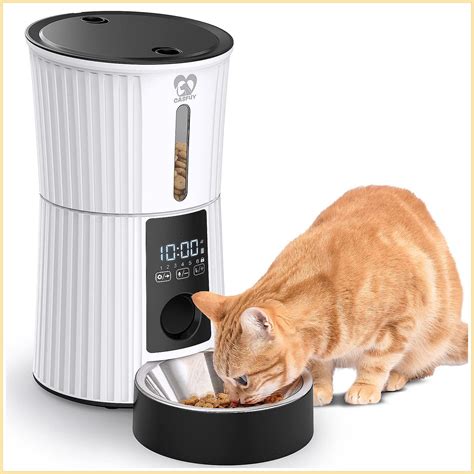Introduction
Automatic cat feeders have revolutionized the way cat owners care for their feline companions. With the advent of advanced technology and continuous innovation, these devices have evolved to offer a plethora of features, convenience, and peace of mind. This comprehensive article will delve into the cutting-edge advancements in automatic cat feeder technology and its impact on the industry.

Advanced Features: Precision and Convenience
Timed Feeding
Automatic cat feeders allow precise scheduling of mealtimes, ensuring your cat receives its food at regular intervals, even when you’re away. This consistency is crucial for maintaining optimal feline health and regular dietary habits.
Portion Control
Overfeeding is a common concern among cat owners. Automatic feeders provide the ability to set precise portion sizes, helping prevent obesity and its associated health risks.
Remote Monitoring
With the integration of Wi-Fi or Bluetooth, modern automatic cat feeders enable remote monitoring and control via smartphone apps. You can adjust feeding times, receive notifications, and monitor your cat’s eating habits from anywhere with an internet connection.
Innovative Technologies: Revolutionizing Feeding
Biometric Identification
Biometric identification technologies, such as facial recognition or microchip scanning, ensure that only your designated cat has access to the feeder. This prevents other animals or unauthorized individuals from accessing the food, maintaining a secure feeding environment.
Anti-Clogging Mechanisms
Automatic feeders incorporate anti-clogging mechanisms to prevent food jams and ensure consistent feeding. These mechanisms include rotating impellers, vibrating plates, or gravity-based systems, reducing the likelihood of disrupted feedings.
Health Monitoring
Emerging automatic cat feeders feature integrated health monitoring capabilities. They can track your cat’s eating patterns, food intake, and weight fluctuations, providing valuable insights into your pet’s overall well-being.
Market Insights and Statistics
According to a study by Grand View Research, the global automatic cat feeder market is projected to reach USD 5.4 billion by 2025, expanding at a CAGR of 6.9%. Factors driving this growth include increasing pet ownership, rising disposable incomes, and the growing demand for advanced pet care technologies.
Regional Market Trends
North America and Europe account for a significant share of the automatic cat feeder market, with high levels of pet ownership and technological adoption. However, Asia-Pacific is estimated to experience the fastest growth due to rising pet ownership rates and increasing urbanization.
Common Mistakes to Avoid
Over-Reliance on Technology
While automatic cat feeders offer convenience and precision, it’s essential to avoid over-reliance. Regularly check the feeder and ensure its functionality, particularly before extended absences.
Improper Food Storage
Automatic cat feeders should be stored in a cool, dry place to maintain the freshness and quality of the food. Avoid exposing the feeder to direct sunlight or moisture, which can compromise the food’s integrity.
Inadequate Cleaning
Regular cleaning and maintenance are crucial to prevent bacterial buildup and ensure optimal performance. Clean the feeder’s bowl, hopper, and mechanism at least once a month to maintain sanitation.
Expansion and Market Opportunities
Smart Integration
Automatic cat feeders can be integrated with smart home systems, enabling seamless integration with other devices and voice-activated controls. This opens up opportunities for remote access, customized routines, and enhanced user convenience.
Pet Tech Growth
The growth of the pet tech industry presents opportunities for innovative applications of automatic cat feeder technology. Advanced features such as activity tracking, health monitoring, and predictive analytics can enhance the overall well-being of feline companions.
Unmet Needs
Identifying unmet needs in the market can drive innovation. Consider addressing areas such as feeding cats with special dietary requirements, accommodating cats with anxiety or specific preferences, and enhancing user experience with intuitive and user-friendly interfaces.
Conclusion
Automatic cat feeder technology has evolved significantly over the years, offering convenience, precision, and innovative features that enhance the lives of both cats and their owners. As the market continues to grow, the integration of advanced technologies, market insights, and a focus on unmet needs will drive further innovation and growth in the coming years. Embracing these advancements will empower cat owners to provide their feline companions with optimal care and well-being.
Supplementary Tables
Table 1: Key Automatic Cat Feeder Features
| Feature | Benefit |
|---|---|
| Timed Feeding | Consistent mealtimes for optimal feline health |
| Portion Control | Prevents obesity and health risks associated with overfeeding |
| Remote Monitoring | Adjust feeding times, receive notifications, and monitor eating habits from anywhere |
| Biometric Identification | Secure feeding environment, preventing access to unauthorized individuals |
| Anti-Clogging Mechanisms | Ensures consistent feeding by preventing food jams |
Table 2: Automatic Cat Feeder Healthcare Innovation
| Feature | Benefit |
|---|---|
| Health Monitoring | Track eating patterns, food intake, and weight fluctuations |
| Food Detection | Alerts the user if the feeder is running low on food |
| Health Reminders | Notifies the user when it’s time for vaccinations or vet appointments |
Table 3: Global Automatic Cat Feeder Market Share by Region (2021)
| Region | Market Share (%) |
|---|---|
| North America | 35% |
| Europe | 27% |
| Asia-Pacific | 22% |
| Latin America | 8% |
| Middle East and Africa | 8% |
Table 4: Common Mistakes to Avoid with Automatic Cat Feeders
| Mistake | Impact |
|---|---|
| Over-Reliance on Technology | Disrupted feeding schedules |
| Improper Food Storage | Food spoilage and reduced nutritional value |
| Inadequate Cleaning | Bacterial buildup and decreased feeder performance |





















